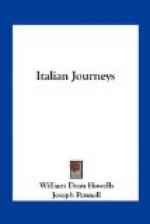II.
Where the road to Herculaneum leaves the bay and its seafaring life, it enters, between the walls of lofty, fly-blown houses, a world of maccaroni haunted by foul odors, beggars, poultry, and insects. There were few people to be seen on the street, but through the open doors of the lofty fly-blown houses we saw floury legions at work making maccaroni; grinding maccaroni, rolling it, cutting it, hanging it in mighty skeins to dry, and gathering it when dried, and putting it away. By the frequency of the wine-shops we judged that the legions were a thirsty host, and by the number of the barber-surgeons’ shops, that they were a plethoric and too full-blooded host. The latter shops were in the proportion of one to five of the former; and the artist who had painted their signs had indulged his fancy in wild excesses of phlebotomy. We had found that, as we came south from Venice, science grew more and more sanguinary in Italy, and more and more disposed to let blood. At Ferrara, even, the propensity began to be manifest on the barbers’ signs, which displayed the device of an arm lanced at the elbow, and jetting the blood by a neatly described curve into a tumbler. Further south the same arm was seen to bleed at the wrist also; and at Naples an exhaustive treatment of the subject appeared, the favorite study of the artist being to represent a nude figure reclining in a genteel attitude on a bank of pleasant greensward, and bleeding from the elbows, wrists, hands, ankles, and feet.




